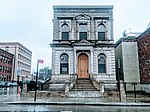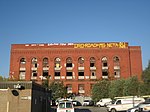Gowanus Batcave

The Central Power Station of the Brooklyn Rapid Transit Company building, commonly known as the Batcave or Gowanus Batcave, is a former transit power station at 153 Second Street in Gowanus, Brooklyn, New York City by the Gowanus Canal. It was built between 1901 and 1904, while the Brooklyn Rapid Transit Company was expanding its rapid transit and streetcar service. It stopped operating in 1972 and sat abandoned for more than two decades, becoming home to a community of squatters in the early 2000s. The owners, who were planning to redevelop the site, building condominiums called "Gowanus Village", had the squatters removed and increased security in 2006. The Gowanus Village plans did not materialize and after a short time it became a popular space for graffiti and underground events. In 2012, philanthropist Joshua Rechnitz purchased the property for $7 million with plans to turn it into The Powerhouse Workshop, an arts space focused on the fabrication of artistic goods. It is managed through the nonprofit Powerhouse Environmental Arts Foundation. In 2019, the New York City Landmarks Preservation Commission designated the Gowanus Batcave as an official city landmark.
Excerpt from the Wikipedia article Gowanus Batcave (License: CC BY-SA 3.0, Authors, Images).Gowanus Batcave
2nd Street, New York Brooklyn
Geographical coordinates (GPS) Address Nearby Places Show on map
Geographical coordinates (GPS)
| Latitude | Longitude |
|---|---|
| N 40.676629 ° | E -73.988899 ° |
Address
2nd Street 153
11215 New York, Brooklyn
New York, United States
Open on Google Maps






